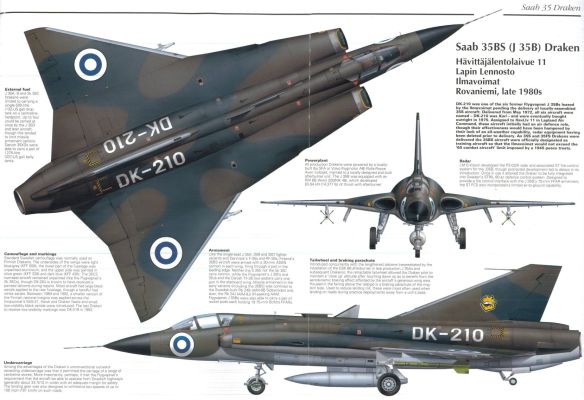One of the most unusual fighters of the 1950s. It featured a license-built Rolls-Royce Avon complete with reheat units installed in a double-delta airframe. This gave the fighter excellent handling characteristics throughout all flight regimes. In the extreme of the nose is installed a radar- tracking unit developed by Ericsson Electronics. This in turn provided guidance for a variety of air-defense missiles that included the U. S.-made Falcon and Sidewinder.
The airframe was eventually equipped with a total of nine pylons capable of carrying missiles, rockets, bombs, or, on the center-line pylons, a selection of fuel tanks. Another innovation built into the aircraft from the outset was the ability to operate from Swedish motorways.
Draken in service
The first J 35 made its maiden flight on 25 October, 1955, at about the same time that the first Lansens were delivered to the Air Force. Deliveries of the J 35A, as the first production version was designated, began in the autumn of 1959 when the first aircraft was handed over to F 13 in Norrköping. Production aircraft had the improved Avon, Air Force designation RM 6B, which was the same as in the ] 32B night-fighter version of the Lansen.
It was obvious early on that the Draken was not just a new aircraft – it represented a whole new generation of aeronautical design in which technology and aerodynamics clearly had leaped forward. Operational conversion of pilots was far from painless and there were numerous accidents in which the aircraft in certain attitudes became uncontrollable – it seemed to just “fall out of the sky” regardless of pilot action, and the only solution appeared to be ejection.
The uncontrollable condition was dubbed a “super-stall” and resulted from the behaviour of the double-delta wing at low speed and high angles of attack. Ways of overcoming the problem were developed but, in order to be able to train pilots better it was decided to design a two-seat Draken. This was designated SK 35C (the J 35B was a recently launched fighter version with improved avionics) and, to speed up deliveries, semi-completed J 35A airframes were taken off the production line and retrofitted with a new forward fuselage, with two seats in tandem. Radar, armament and one fuselage fuel tank were removed and the improved thrust-to-weight ratio made the SK 35 faster than the front-line fighter, earning it the nickname “Saab 35 Sport”.
Forty years of frontline service!
Later, the fighter Draken was further improved as the J 35B was developed into the ‘D with an uprated RM 6C (Avon Series 300) engine and two 20 mm cannon instead of one. The Saab 35E was a photo-reconnaissance version (nine different cameras), while the J 35F and F-Il had further improved radar and avionics in addition to new missile armament.
The J 35Fs were adapted to the new Stril 60 warning and control system, having provisions for semi-automatic fighter control. In all, six different fighter versions have been delivered to the Swedish Air Force, the latest being the J 35J which basically is an upgraded J 35F with new avionics and further enhanced missile armament. The J 35J version was delivered in the late 1980s and was serving the Air Force at F 10 wing at Ängelholm, in the south-west of Sweden until December 8,1998, when the last mission was flown (seven of the reamining Draken flew a ‘farewell mission’ over the southern part of Sweden in ‘Christmas Tree’-formation).
By 1999, the Draken had seen 40 years in frontline service in Sweden, Denmark, Finland and Austria. Switzerland was for a while a potential customer and countries such as Australia and Brazil also showed an early interest. In all, 604 Drakens were built, including the prototypes, and the aircraft has also been exported to Denmark (new aircraft, as F-35 fighters, RF-35 photo-reconnaissance and interceptors, and TF-35 armed trainers), Finland (35BS and 35S, new and used aircraft) and Austria (350E, used, rebuilt Saab 35Ds). A few are also in private hands in the United States.
